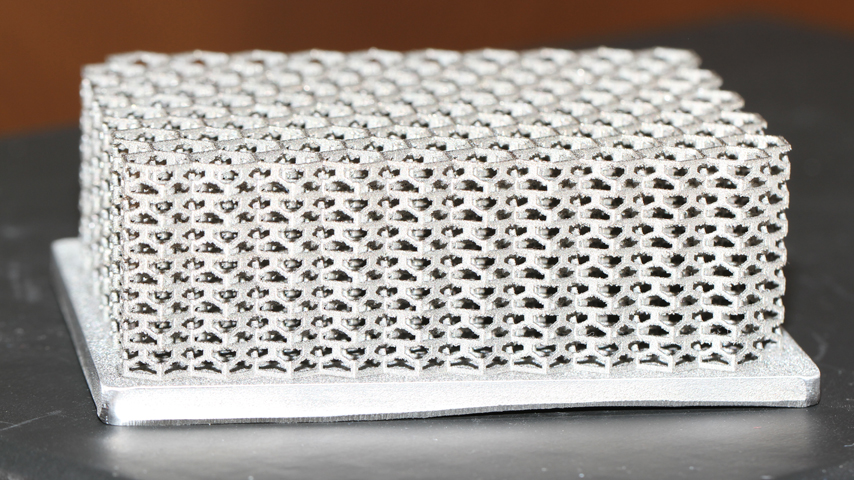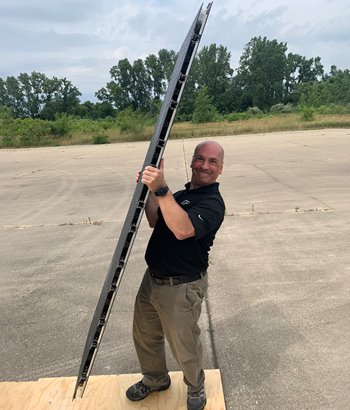Researchers Craft Stress-Resistant Materials
Researchers Craft Stress-Resistant Materials


Purdue University researchers draw inspiration from nature to create robust, lightweight materials capable of withstanding stress without undergoing unwanted deformation.
In civil engineering, designers typically avoid buckling failures. However, purposefully incorporating controlled buckling into a structure’s design enables the assembly to deform (buckle) under applied forces and promptly rebound to its initial shape when the force is withdrawn.
While each design possesses a threshold for withstanding plastic deformation, architected materials are specifically engineered to undergo controlled buckling at a defined point and transfer the forces to other structural components to uphold the product’s integrity.
Engineers can design for various purposes and materials, tailoring to the product’s intended use. Even concrete, a material typically considered brittle, can undergo design modifications to absorb kinetic energy without breaking. Concrete traditionally finds use in applications demanding substantial, thick components to uphold buildings, bridges, and other sizeable structures. However, when concrete is exceptionally thin—typically achieved through 3D printing—it can be fashioned to flex and subsequently revert to its initial shape.
The intricate geometry of architected materials makes 3D printing an optimal production method. It allows for complex shapes with minimal retooling and reduced waste. Additionally, 3D printing supports material design in one location and production in another, thanks to the electronic transmission of 3D files to global manufacturers. To ensure effective energy absorption without undergoing plastic deformation, it is imperative to enforce strict quality control procedures for these products.
If the material structure is meant to buckle at a defined force threshold but surplus material is added during printing, it may not buckle as intended or may exhibit irregular buckling, introducing unforeseen stresses to other components. Alternatively, conventional manufacturing methods like machining, extrusion, and stamping can be employed, but these approaches entail additional labor costs for assembling the individual structure pieces.
Human bones consist of millions of flattened spherical structures arranged in a honeycomb-like pattern. The gaps between these structures facilitate circulation of blood, nutrients, and oxygen, while simultaneously eliminating waste. This arrangement enhances the bone structure’s strength, while preserving its lightweight and healthy quality. Similarly, heavy paper, known as cardboard, comprises two sturdy outer paper layers combined with fluted or corrugated paper.
The geometry, layering, and thickness of the corrugated paper section create varying degrees of flexibility and strength, all while preserving its lightweight nature. “I'm interested in the mechanics of materials. One of the fascinating things about materials is that they have patterns in nature; like a seashell or trees, they have geometry,” explained Pablo Zavattieri, a Jerry M. and Lynda T. Engelhardt professor of civil engineering at Purdue University.
Drawing inspiration from these patterns in nature, engineers can apply similar designs to structures of considerable scale, such as buildings or bridges needing to endure earthquakes, tsunamis, or other natural disasters. Alternatively, these designs can extend to smaller applications, like enhancing helmet impact resistance or biomedical uses. “Instead of transforming this impact energy into plastic deformation and damage, it transforms elastic energy into kinetic energy. Creating a material that can absorb energy without deforming permanently,” he said.
Collaborating with Indiana Technology and Manufacturing Companies (ITAMCO), Zavattieri and his team engineered a runway mat using 3D-printed metal to serve as a landing surface for temporary flight operations. The designed mat proved light enough for a single person to carry its individual segments (each measuring approximately 6 feet by 3 feet). It underwent a 60-day test period, enduring over 5,000 landing and takeoff cycles, without exhibiting any deformation or failure.
A stark contrast to the previous mats, which required machinery for relocation and failed after about 1,500 cycles. Although the development and production of the architected mats incurred slightly higher costs, their extended lifespan and portability translate into long term cost savings.
The team also aims to explore similar designs utilizing optical, magnetic, or thermal properties to alter the shape and size of objects. Materials capable of folding to fit inside a catheter and expanding to the final shape when heated by body temperature hold the potential to enhance access to different areas of the body while minimizing the surgical impacts on patients through smaller incisions.
If you can print small things, then you can use the temperature in the body to create motion and serve biomedical applications,” Zavattieri said.
Abundant free space within the structure supports lightweight designs through complex geometry, facilitating controlled buckling under force and prompt rebounding once the force is removed. Applications span earthquake-resistant structures to biomedical uses, with 3D printing providing optimal flexibility for crafting intricate designs. 3D printing, with its versatility and minimal waste, requires strict quality control measures to ensure effective energy absorption without irregular buckling. The exploration of materials with optical, magnetic, or thermal properties holds promise for advancing biomedical applications in the field.
Nicole Imeson is an engineer and writer in Calgary, Alberta.
While each design possesses a threshold for withstanding plastic deformation, architected materials are specifically engineered to undergo controlled buckling at a defined point and transfer the forces to other structural components to uphold the product’s integrity.
Engineers can design for various purposes and materials, tailoring to the product’s intended use. Even concrete, a material typically considered brittle, can undergo design modifications to absorb kinetic energy without breaking. Concrete traditionally finds use in applications demanding substantial, thick components to uphold buildings, bridges, and other sizeable structures. However, when concrete is exceptionally thin—typically achieved through 3D printing—it can be fashioned to flex and subsequently revert to its initial shape.
3D Printing
The intricate geometry of architected materials makes 3D printing an optimal production method. It allows for complex shapes with minimal retooling and reduced waste. Additionally, 3D printing supports material design in one location and production in another, thanks to the electronic transmission of 3D files to global manufacturers. To ensure effective energy absorption without undergoing plastic deformation, it is imperative to enforce strict quality control procedures for these products.
If the material structure is meant to buckle at a defined force threshold but surplus material is added during printing, it may not buckle as intended or may exhibit irregular buckling, introducing unforeseen stresses to other components. Alternatively, conventional manufacturing methods like machining, extrusion, and stamping can be employed, but these approaches entail additional labor costs for assembling the individual structure pieces.
Patterns in nature
Human bones consist of millions of flattened spherical structures arranged in a honeycomb-like pattern. The gaps between these structures facilitate circulation of blood, nutrients, and oxygen, while simultaneously eliminating waste. This arrangement enhances the bone structure’s strength, while preserving its lightweight and healthy quality. Similarly, heavy paper, known as cardboard, comprises two sturdy outer paper layers combined with fluted or corrugated paper.
The geometry, layering, and thickness of the corrugated paper section create varying degrees of flexibility and strength, all while preserving its lightweight nature. “I'm interested in the mechanics of materials. One of the fascinating things about materials is that they have patterns in nature; like a seashell or trees, they have geometry,” explained Pablo Zavattieri, a Jerry M. and Lynda T. Engelhardt professor of civil engineering at Purdue University.
Drawing inspiration from these patterns in nature, engineers can apply similar designs to structures of considerable scale, such as buildings or bridges needing to endure earthquakes, tsunamis, or other natural disasters. Alternatively, these designs can extend to smaller applications, like enhancing helmet impact resistance or biomedical uses. “Instead of transforming this impact energy into plastic deformation and damage, it transforms elastic energy into kinetic energy. Creating a material that can absorb energy without deforming permanently,” he said.
Runway mats
Collaborating with Indiana Technology and Manufacturing Companies (ITAMCO), Zavattieri and his team engineered a runway mat using 3D-printed metal to serve as a landing surface for temporary flight operations. The designed mat proved light enough for a single person to carry its individual segments (each measuring approximately 6 feet by 3 feet). It underwent a 60-day test period, enduring over 5,000 landing and takeoff cycles, without exhibiting any deformation or failure.
A stark contrast to the previous mats, which required machinery for relocation and failed after about 1,500 cycles. Although the development and production of the architected mats incurred slightly higher costs, their extended lifespan and portability translate into long term cost savings.
The team also aims to explore similar designs utilizing optical, magnetic, or thermal properties to alter the shape and size of objects. Materials capable of folding to fit inside a catheter and expanding to the final shape when heated by body temperature hold the potential to enhance access to different areas of the body while minimizing the surgical impacts on patients through smaller incisions.
If you can print small things, then you can use the temperature in the body to create motion and serve biomedical applications,” Zavattieri said.
Abundant free space within the structure supports lightweight designs through complex geometry, facilitating controlled buckling under force and prompt rebounding once the force is removed. Applications span earthquake-resistant structures to biomedical uses, with 3D printing providing optimal flexibility for crafting intricate designs. 3D printing, with its versatility and minimal waste, requires strict quality control measures to ensure effective energy absorption without irregular buckling. The exploration of materials with optical, magnetic, or thermal properties holds promise for advancing biomedical applications in the field.
Nicole Imeson is an engineer and writer in Calgary, Alberta.





